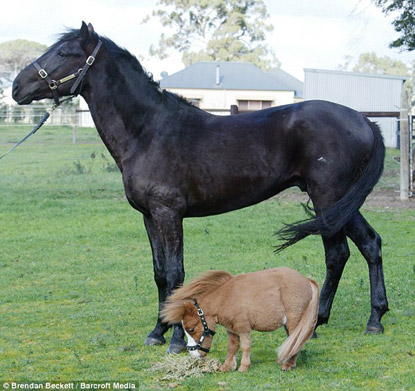Today John Sharp showed me this insanely cute dwarf miniature horse, named Koda. He’s about as big as a cat, so noticeably smaller than a normal miniature horse because he is, well, a dwarf.
One of my favorite sidetrips in Graham Harman’s Guerilla Metaphysics (back in print soon) is his theory of cuteness, which I find to be the most convincing and elegant treatment of the notion around. Here’s the key passage, from page 142 of the book:
Cute objects are either lovely, or else they are delightfully absorbed in some technique that we ourselves take for granted. That is to say, certain actions are performed by certain worldly agents with a regularlity and ease devoid of any hesitation. Horses gallop, donkeys eat, humans write letters, and native speakers of a language use it fluently. The labors of such agents become “cute” when they are slightly underequipped for their task: a newborn horse trying to prance on its skinny, awkward legs; a sweet little donkey trying to eat a big pile of hay with its sweet little mouth and tongue; a child handing us a thank-you note with imperfect grammar; a foreigner misusing our language in slightly incorrect but delightfully vivid fashion. In each of these cases, the cute agent is one that makes use ofimplements of which it is not fully in command.
Koda realizes one of Harman’s examples (the little donkey). He really drives home the soundness of this account of cute, and also why it is different from Japanese cuteness: the latter produces a sense of protection and innocence; the former accounts for a much broader scope of slight inabililty, one that has nothing to do with parental instinct and everything to do with the delight of slight insufficiency.
From a design perspective, cuteness has been so taken over by the Japanese Sanrio variant, especially in popular media like videogames with many imports, that we’ve lost touch with this other, more “Western” version of cuteness. Pokémon or Yoshi or Kirby are enormously competent, which isn’t necessarily how cute reads. A truly cute character or situation doesn’t just relate to its appearance and features, but also to its abilities. But I can think of precious few characters from toys or videogames or other media that are cute in this way. Mostly such characters appear, rather than behave.

Comments
amarilla
It’s a kind of conspicuous cluelessness, and we all demonstrate it sooner or later. Like yesterday when at Coney Island a Russian woman came and sat down right on my friend’s bag, under her umbrella, as if she never in her life had been to the beach before and had no concept of personal property. This was cute verging on awkward, and it is raw material for many comedians like Larry David.
I guess this is a better example of cute: http://brooklynometry.blogspot.com/2007/09/chinatown-gift-shop-ben-10-watch.html
Mark J. Nelson
This reminds me in an odd way of John Holt‘s attacks on children being perceived as cute in his polemical Escape from Childhood (1974). He basically sees cuteness as a subjugation move that attempts to portray the “cute” object as a mildly incompetent version of some other object that serves as the norm.
(Presented without endorsement; just thought it was interesting that I’d run across something similar before, but with a very different sentiment attached.)
William Huber
The cases of Japanese cuteness that you identify are, interestingly, those that appeal to young boys: they are cuteness charged with efficacy and dynamic energy. (They are, of course, not representative of the universe of cute things in Japanese media culture – they are those brands most successfully marketed to young western males.)
I think, too, that what you call western cuteness is highly gendered and part of the formation of gender. Videogame avatars have to be efficacious, or else they are game patients. The characters in “Loco Roco” and other such games, in which the avatars are, in fact, passive or relatively inefficacious, are telling in that they are (often) Japanese version of just such a “cute” underequippedness.
Ian Bogost
William, this is really interesting. I want to understand it more. Can you explain the Japanese version of underequipped cuteness a bit more?
lelak
“Japanese cuteness” seems to fall into what I’ve generally thought of as “cutesy”.
Ian Bogost
Interesting. I’ve always heard “cutesy” as sort of a sickly sweet mawkishness, a cuteness applied for excess. In that respect, I can see the connection.